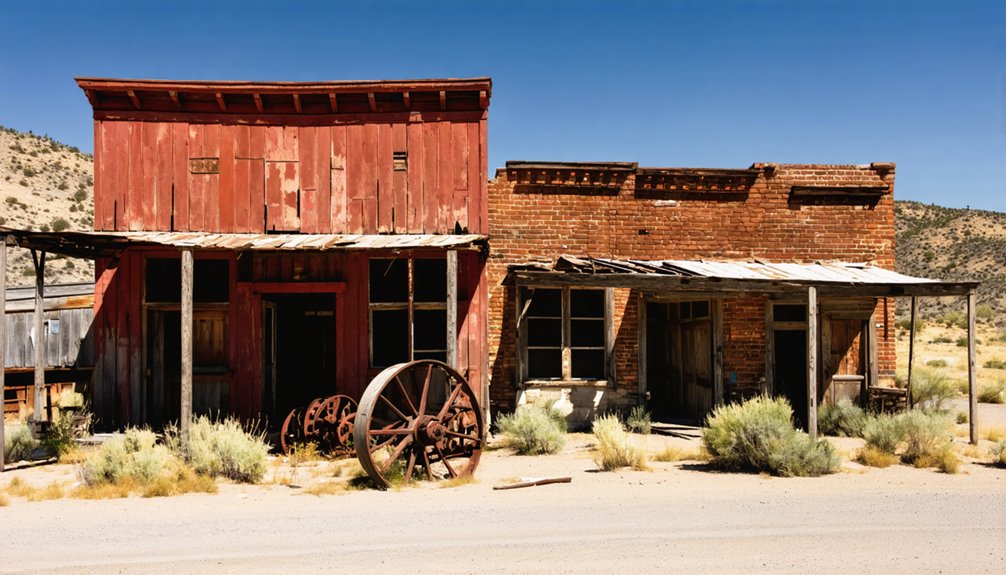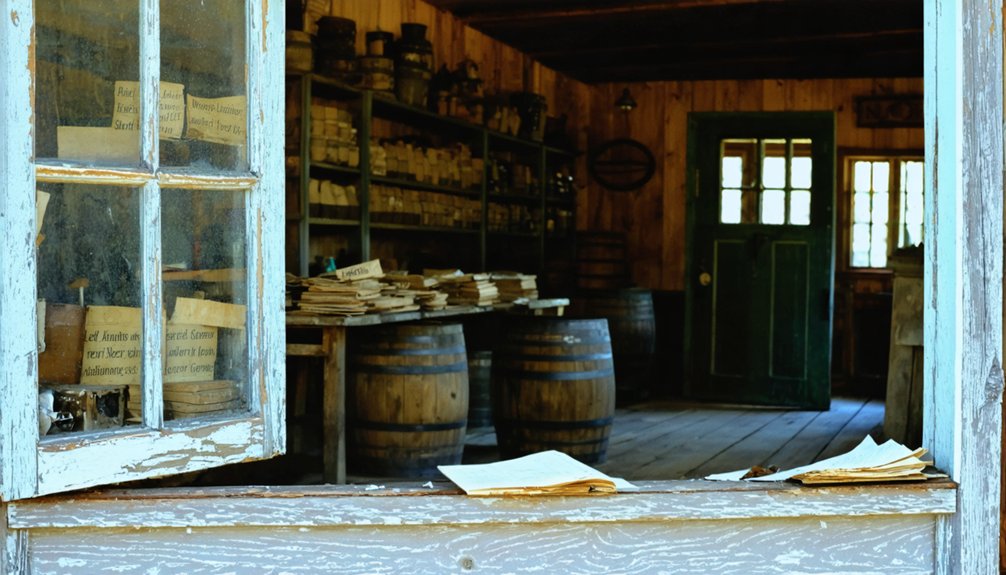Lee Camp emerged as a California gold rush boomtown in 1905 when prospectors discovered gold in the Funeral Mountains. You’ll find its remains in the harsh Mojave Desert, where it once housed 600 residents with saloons, restaurants, and mining operations. The town competed economically with Rhyolite before the Panic of 1907 triggered its decline. By 1912, its post office closed, marking its abandonment. This desert ghost town tells a deeper story of boom-and-bust resilience.
Key Takeaways
- Lee Camp was a gold rush boomtown established in 1905 in the Mojave Desert after discoveries in the Funeral Mountains.
- At its peak in 1907, the town had approximately 600 residents and rivaled Rhyolite, Nevada as an economic center.
- Residents faced extreme desert conditions, including water shortages that cost five dollars per barrel from Rose Well.
- The Panic of 1907 triggered the town’s decline, with population dropping dramatically by 1908.
- The post office closed in 1912, marking the official end of Lee Camp as residents abandoned the area.
The Gold Rush That Started It All
When gold was discovered in early 1905 on the western slopes of the Funeral Mountains near Echo Canyon, it ignited a fever that would transform the California landscape into yet another demonstration of humanity’s enduring obsession with precious metals.
As news of the gold discovery spread to established mining towns like Bullfrog and Rhyolite, prospectors who’d missed earlier opportunities rushed to stake their claims in this promising new territory.
Within weeks, Lee, California emerged as a boomtown, complete with restaurants, saloons, and general stores serving the influx of fortune-seekers.
The mining culture that developed reflected the chaotic nature of these rushes—claim disputes were common, with valuable properties sometimes sold multiple times to different buyers. These dynamics were further complicated by the diverse composition of miners from various ethnic backgrounds, which influenced both mining practices and community relations. The growing community required security measures similar to those used today to protect valuable assets and maintain order.
Merchants from neighboring settlements quickly established branches in Lee, capitalizing on the economic boom that always accompanied these passionate surges toward potential wealth.
Birth of the Lee Mining District
While the earlier gold strikes of the Bullfrog rush had already transformed the Death Valley region by 1904, it wasn’t until early 1907 that the Lee Mining District truly established itself as a distinct entity in the lower Funeral Mountains.
The Bullfrog gold fever predated Lee Mining District’s emergence, which only distinguished itself in the Funeral Mountains by 1907.
This emerging district stretched from Schwab Camp westward to the Lee mines on the eastern flank, existing within a vibrant regional network of mining activity.
In just four months between January and April 1907, the area saw an explosion of development with ten new mining companies launching operations.
Prospectors staked mining claims using physical markers and detailed notices that specified ownership, dimensions, and target minerals.
The district’s geological discoveries included promising gold deposits, with silver zones identified separately, reflecting the complex mineralization patterns characteristic of the Funeral Mountains’ ancient fault systems. Like the mining communities at Bodie and Lundy, these operations required substantial timber resources for construction and extraction work. Before the districts merged, Chet Leavitt made a significant gold discovery in Echo Canyon that stimulated renewed interest in the region.
Life in a Desert Boomtown
Living in Lee’s desert boomtown meant confronting harsh environmental realities while pursuing the promise of mineral wealth.
You’d face water scarcity, extreme temperature fluctuations, and the constant need to transport essential supplies across difficult terrain.
Despite these hardships, residents established daily routines centered around mining operations, community gatherings, and the shared understanding that your home might disappear as quickly as it emerged. The discovery of gold in the American West triggered massive migration as approximately 300,000 individuals traveled to California seeking fortune in places like Lee Camp. Water was particularly precious, sourced from Rose Well and costing residents five dollars per barrel.
Desert Mining Challenges
The harsh Mojave Desert presented miners at Lee Camp with challenges that would test even the most determined prospectors. You’d face brutal heat while wielding primitive mining techniques like picks and pans, later advancing to steam-powered equipment as shallow deposits depleted.
Water scarcity became your constant enemy, with every drop precious for survival and ore processing.
Underground shafts brought new dangers: unstable tunnels, poor ventilation, and the risk of deadly cave-ins. Your tools wore down quickly in the abrasive environment, requiring frequent replacement at considerable expense. The early boomtown settlements rapidly emerged as miners flocked to promising areas, mirroring the pattern seen throughout California’s gold country.
The environmental consequences were severe—mercury used in amalgamation poisoned waterways, while hydraulic mining permanently scarred the landscape.
Transporting ore across difficult terrain to distant processing facilities consumed both your profits and energy, making success elusive for all but the luckiest claims.
Like the miners at Death Valley’s Rhyolite and Chloride City, those at Lee Camp witnessed how rapidly a mining town collapsed when ore deposits were exhausted or deemed unprofitable.
Community Without Permanence
As Lee Camp mushroomed from the dusty Mojave landscape following the 1904 Bullfrog mining rush, it embodied the quintessential desert boomtown—vibrant yet inherently impermanent.
You’d have found a community of roughly 600 souls living in framed tents that housed essential services—a store, saloon, lodging house, and restaurant.
Community dynamics revolved around these simple gathering places where miners sought respite from their labor. The Echo mining district formed in 1905, establishing a backbone for the camp’s brief economic activity. The transient lifestyle was evident in everything: shops appeared and vanished with the fortunes of the mines, while cloudbursts could obliterate roads overnight. Like Ballarat and other supply points, Lee Camp served the Panamint Range mines with essential goods and services.
When the 1907 panic slowed mining operations, residents drifted away like tumbleweeds.
Without water, wood, or electricity, permanence was impossible. The harsh desert environment constantly reminded inhabitants that Lee Camp existed solely at the mercy of gold yields and nature’s whims.
Daily Survival Rituals
Within the harsh embrace of the Mojave’s unforgiving landscape, daily survival at Lee Camp demanded ingenuity and steadfast routine from its 600 residents.
You’d awaken to the 8 A.M. departure of McArthur’s auto service, joining miners headed to claims or merchants opening their establishments for the day’s commerce.
Survival strategies centered around the town’s growing infrastructure. You’d frequent the general store for essential supplies, dine at the restaurant, or visit one of several saloons where information about employment circulated.
Resource management remained paramount—lumber arrived by wagonloads, carefully allocated for ongoing construction.
The hiring hall became your lifeline, connecting you with mining operations’ steady demand for labor.
Despite rival settlements in Nevada and California creating dual economies, you’d navigate both to maximize opportunity in this precarious desert existence.
Peak Population and Economic Boom

During its brief heyday, Lee Camp swelled to approximately 600 residents by 1907, transforming this California outpost into a competitive economic center that rivaled neighboring Rhyolite, Nevada.
This population boom reflected the classic mining town trajectory, with dramatic economic fluctuations tied directly to mineral extraction cycles.
You would have found a bustling community anchored by multiple saloons, a hiring hall, and commercial establishments catering to miners and service workers alike.
The town’s population dynamics mirrored the fortunes buried in the Funeral Mountains district, rising rapidly after the 1905 founding but beginning to decline by 1910 as ore yields diminished.
This five-year prosperity window typified the fragile boom-and-bust pattern of early 20th-century western mining towns, where opportunity flared briefly before fading.
Daily Life and Infrastructure
Life in Lee Camp centered around sparse infrastructure and rudimentary living conditions that typified frontier mining settlements of the early 1900s.
You’d find yourself living in a tent rather than permanent housing, despite the few stone foundations that indicated more durable construction attempts. Water, piped from Talus Canyon springs, represented one of the few infrastructure achievements, though its scarcity posed constant challenges to daily routines.
The stark reality of tent living under endless sky, punctuated by stone remnants of dreams and precious trickles of canyon water.
Without electricity, you’d rely on charcoal produced in local kilns for cooking and heating.
Twice-weekly stage service connected you to civilization, bringing supplies and mail. The community hub consisted primarily of saloons, grocery stores, and restaurants where miners gathered after work.
Despite the Tonopah and Tidewater Railroad’s arrival in 1906, infrastructure challenges persisted, ultimately limiting Lee’s growth and contributing to its eventual abandonment.
The Panic of 1907 and Its Impact

When the Panic of 1907 struck the nation, Lee Camp’s fragile mining-based economy collapsed as capital dried up and commodity prices plummeted by 21 percent.
You’d have witnessed the once-bustling mining operations grind to a halt as small corporations tied to affected trust companies saw their stock prices plunge and investment rates fall by nearly half.
The subsequent exodus of miners searching for work elsewhere transformed the vibrant settlement into a shell of its former self, with unemployment rates nearly tripling as residents abandoned homes and businesses.
Financial Crisis Aftermath
As the dust settled following the Panic of 1907, the United States faced one of its most severe economic contractions prior to the Great Depression. You’d have witnessed GNP plummeting by 11% and industrial production collapsing by 16%, while unemployment nearly tripled to 8%.
The crisis exposed fundamental weaknesses in America’s financial system, particularly the unregulated trust companies that contracted lending by 40%.
Without a central bank, the nation’s economic recovery depended on private interventions from J.P. Morgan and John D. Rockefeller, who orchestrated emergency loans and corporate bailouts.
This financial resilience came at a cost: the panic accelerated reforms culminating in the Federal Reserve System.
The hard lessons of 1907—market volatility, bank runs, and credit contraction—ultimately strengthened America’s financial architecture for generations to come.
Mining Operations Halt
The Panic of 1907 struck Lee Camp’s mining operations with devastating force, triggering a cascade of shutdowns throughout the Echo-Lee mining district. As capital evaporated, mining technology investments halted abruptly—equipment purchases froze while maintenance declined.
You’d have witnessed mines closing in rapid succession by late October, with only Lee Camp maintaining operations while neighboring sites collapsed.
Labor dynamics shifted dramatically as workforce reductions became inevitable. Miners departed in waves beginning in late 1907, creating skilled labor shortages that further crippled remaining operations.
The economic constraints tightened as credit disappeared and gold prices wavered, making profitability impossible for most operations. Though Lee Camp showed remarkable resilience compared to its neighbors, it couldn’t escape the financial stranglehold.
Exodus of Miners
October 1907 marked the beginning of Lee Camp’s mass exodus, transforming a once-vibrant mining community into a landscape of abandoned claims and vacant buildings. The Panic, triggered by the failed United Copper stock scheme, severed the financial arteries feeding Lee Camp’s operations.
You would have witnessed miners and their families loading wagons as bank runs and credit freezes strangled the town’s economy. With unemployment doubling nationwide, these workers joined the mining migration toward urban centers. The evaporation of speculative capital meant companies could no longer sustain operations, forcing mass layoffs.
Lee Camp’s economic collapse mirrored other mining towns throughout Death Valley’s periphery. By 1915, the workforce had scattered, leaving behind empty homes and rusting equipment—silent monuments to the financial mechanisms that broke this town’s spirit before it could mature.
Decline and Abandonment

Following the devastating Panic of 1907, Lee Camp’s once-promising future quickly unraveled as economic turmoil gripped the isolated mining community.
The promise of prosperity vanished overnight as financial chaos engulfed the remote miners of Lee Camp.
The mining decline accelerated as businesses shuttered, with only three stores, two saloons, and one restaurant remaining by mid-1908.
You’d have witnessed the population plummet from 2,000 to just 300 men and 20 women, signaling the economic collapse was well underway.
The town’s demise was hastened by:
- Closure of the post office in 1912, ending official services
- Destruction of Emigrant Wash Road by a cloudburst in August 1908
- Water supply challenges that undermined sustainability
- Consolidation of mining operations at Greenwater, drawing away remaining workers
Visiting Lee Camp Today
Hidden within the rugged terrain of Kern County, California, Lee Camp stands today as a shadow of its former self, presenting unique challenges and rewards for adventurous visitors.
To reach this remote ghost town, you’ll need a high-clearance vehicle capable of traversing unpaved, sometimes eroded roads that wind through the Funeral Mountains.
Unlike preserved ghost towns, Lee Camp offers an authentic ghost town exploration experience—stone foundations, cellar sites, and mining tailings remain scattered across the landscape with minimal interpretive signage.
You must bring all necessary supplies, as no services exist on-site. Basic desert survival knowledge is essential, including carrying ample water and wayfinding tools.
Though officially listed on the National Register of Historic Places since 1974, Lee Camp remains in a state of natural decay within Death Valley National Park boundaries.
Historical Significance and Legacy
Lee Camp’s weathered remnants tell a deeper story beyond the physical ruins visitors encounter today. Within its historical context, this settlement exemplifies the classic boom-and-bust cycle that defined early 20th-century mining towns throughout the Mojave Desert region.
The camp’s brief existence offers a window into America’s resource-driven expansion.
Lee Camp’s mining legacy remains significant for several reasons:
- It demonstrates how railroad connections (via Leeland and the Tonopah and Tidewater Railroad) transformed isolated mineral deposits into viable economic ventures.
- Its rapid rise and fall mirrors countless other gold rush settlements dependent on finite resources.
- The camp illustrates the environmental challenges faced by desert mining operations.
- It represents the entrepreneurial spirit and mobility of western prospectors who followed opportunity regardless of hardship.
Frequently Asked Questions
Were Any Notable Outlaws or Gunfights Reported in Lee Camp?
Despite thorough historical research, you’ll find no documented outlaw legends or specific gunfight stories directly associated with Lee Camp, though the Death Valley region attracted fugitives seeking freedom from authorities.
What Happened to the Residents After Lee Camp Was Abandoned?
Like dust in the wind, you’d have scattered with other residents’ migration toward Echo, Harrisburg, or Leeland. You’d have abandoned properties, shifted to transport jobs, or completely left the region after the 1907 mining slowdown.
Did Lee Camp Have a Cemetery or Burial Grounds?
No, you won’t find documented evidence of a cemetery at Lee Camp. Historical records and archaeological surveys reveal no burial grounds, despite cemetery history often being preserved in other mining settlements’ burial customs.
Was Lee Camp Connected to Any Other Ghost Towns Nearby?
Yes, Lee Camp was directly connected to Lee, Nevada across the state line. You’ll find they shared infrastructure with Lee Annex while maintaining transport links to Rhyolite through the Tonopah & Tidewater Railroad.
Were There Any Indigenous Peoples’ Settlements in the Area Before Mining?
Like ancient springs in a desert of time, you’ll find that Nisenan and Southern Maidu peoples occupied this land for millennia. Their indigenous history reveals native tribes managing resources seasonally before miners claimed their territories.
References
- https://www.legendsofamerica.com/ca-deathvalleyghosttownscalifornia/
- https://www.youtube.com/watch?v=OQCENqxYJKs
- https://www.desertusa.com/desert-activity/nevada2.html
- https://www.walkingwildandfree.com/lees-camp-road/
- https://www.youtube.com/watch?v=y_0pal_g9LA
- https://www.nps.gov/parkhistory/online_books/deva/section4b6.htm
- https://www.goodreads.com/book/show/346972.Roaring_Camp
- https://www.ebay.com/itm/388986347468
- https://florenceandthehistorian.wordpress.com/2013/01/14/book-review-roaring-camp/
- https://history.wisc.edu/publications/roaring-camp-the-social-world-of-the-california-gold-rush/



